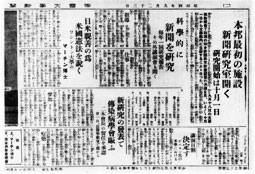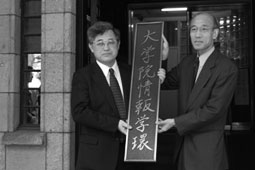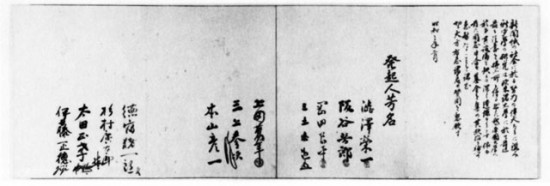新聞学やマス・メディア研究をリードした先駆的研究機関の75年のあゆみThe 75-year history of a pioneering research institution at the forefront of journalism and mass-media studies
2004年に情報学環と組織統合した東京大学社会情報研究所は、東京帝国大学文学部新聞研究室を前史とし、東京大学新聞研究所を継承して改組された国立大学附置研究所であり、社会情報学やメディア・コミュニケーション研究の総合的機関でした。

1929年、東京帝国大学文学部に新聞に関する学術研究施設として新聞研究室が設置されました。新聞研究室は、東京帝国大学の法学部、文学部、経済学部からそれぞれ1名の指導教授が参加し、1名の指導補助、3名の研究員が置かれるという横断的連携機関でした。その学際的な研究組織の運営は、渋沢栄一、阪谷芳郎、本山彦一、徳富蘇峰、杉村廣太郎といった、当時の財界や新聞界の名士たちが協力して募られた寄付金によって賄われ、産学連携の先駆けとなる形態をとっていました。設立時の新聞研究室の指導教授としては、南原繁(法学部)、戸田貞三(文学部)、河合栄治郎(経済学部)という、戦前日本の法学、社会学、経済学を代表する研究者が参画し、指導補助として実質的な研究組織の中核を担った小野秀雄(初代新聞研究所長)を支えていました。
このような前史を経て、1949年に、東京大学附置研究所として新聞研究所が発足しました。新聞研究所は、「新聞及び時事についての出版、放送又は映画に関する研究、並びにこれらの事業に従事し、又は従事しようとする者の指導及び養成」(国立学校設置法)と規定されていたように、マス・メディア一般を対象とする包括的な研究機関でした。1950年には教育部を設置して研究生制度を開始するとともに、その後、社会科学研究科の社会学専修課程B(新聞学コース)の教育に携わることになりました。
やがて、新聞研究所はマス・コミュニケーションの発展を受けて組織の拡充と研究部門の再編を重ねていきました。1957年からは、基礎部門:マス・コミュニケーション理論、歴史部門:マス・コミュニケーション史、特殊部門1:コミュニケーション過程、特殊部門2:マス・コミュニケーション・メディア、特殊部門3:世論及び宣伝、という5つの研究部門の構成となり、これに1963年からは放送部門が、さらに1974年からは情報社会部門が、1980年からは社会情報システム部門が加わりました。この部門構成から明らかなように、新聞研究所は、社会的コミュニケーション、情報の社会的側面に関する先端的な研究の中枢を担う研究機関として実績を積み上げてきました。
そして、1992年、「社会情報の総合的研究」を目指して新聞研究所から社会情報研究所への改組が行われました。社会情報研究所は、「情報メディア」、「情報行動」、「情報・社会」という3大部門を置き、情報メディア研究資料センターを附置するという体制をとって、文部省科学研究費重点領域研究「情報化社会と人間」(1992~1995年)をはじめ、情報化社会に対する学際的な取り組みを進めました。また、社会学研究科の社会学専攻(専門課程)B(新聞学)およびB(社会情報学コース)、その後、人文社会系研究科の社会文化研究専攻(社会情報学専門分野)の教育に携わりました。1996年には、小池唯夫(毎日新聞社長)、川口幹夫(NHK会長)、関本忠夫(日本電気会長)、大塚信一(岩波書店社長)、福川伸次(電通総研所長)を産業界パネル委員として外部評価を実施し、非常に高い評価を得ました。
 社会情報研究所は、東京大学における情報をめぐる研究教育体制の再編の議論に積極的に関わり、情報学環・学際情報学府の設立構想に主体的に参加し、人的リソースの提供において文系部局として最大の貢献を果たしました。情報学環・学際情報学府の設立後も緊密な関係を維持し、支援を続けてきました。そして2004年、国立大学法人化にともなう国立大学附置研究所の見直し方針のなかで、社会情報研究所は情報学環との統合を選択し、大学院組織へと全面的に移行しました。
社会情報研究所は、東京大学における情報をめぐる研究教育体制の再編の議論に積極的に関わり、情報学環・学際情報学府の設立構想に主体的に参加し、人的リソースの提供において文系部局として最大の貢献を果たしました。情報学環・学際情報学府の設立後も緊密な関係を維持し、支援を続けてきました。そして2004年、国立大学法人化にともなう国立大学附置研究所の見直し方針のなかで、社会情報研究所は情報学環との統合を選択し、大学院組織へと全面的に移行しました。
情報学環と社会情報研究所の組織統合によって誕生したのは、東京大学が21世紀の情報社会のなかで世界的なリーダーシップを示していく最前線となる研究教育組織です。情報学環が先端的に取り組んできた「生命・思想」「システム・言語」「表現・造形」「環境・認知」「社会・制度」等の学域と、社会情報研究所が75年にわたって蓄積してきた「ジャーナリズム・メディア」「行動・機能」「法・政策」「経済・産業」「文化・歴史」等の学域を相互浸透させ、文理融合の情報学研究の基盤を築いています。また、理論的・技術的な知識と、社会的・文化的な知識を結合させた情報学の国際的フロンティアを養成するための学際的教育を実施しています。
The Institute of Socio-information and Communication Studies, which merged with the III in 2004, was a national university research institute devoted to the comprehensive study of socio-information, media and communication. Its history can be traced back to the days of the prewar Tokyo Imperial University.
In 1929, a research department for journalism studies was established in what was then the Faculty of Letters at Tokyo Imperial University. It was a cooperative interdisciplinary organization composed of three professors recruited respectively from the Faculties of Law, Letters, and Economics. Its establishment was facilitated by grants from major figures in the worlds of finance and newspaper publishing. Besides being interdisciplinary, it was thus also an early example of cooperation between university and industry. The three professors affiliated to it at its inception (Shigeru Nambara, Teizo Toda, and Eijiro Kawai) were all major researchers in their respective fields of law, sociology and economics at the time. They were assisted by Hideo Ono, who later became the first director of the Institute of Journalism and Communication Studies (the precursor of the Institute of Socio-information and Communication Studies).
Following the postwar reorganization of the university, the Institute of Journalism and Communication Studies was established as a research institute in 1949. Its brief was “to pursue research on newspapers, publications about current affairs, broadcasting and film, and to provide direction and training to those seeking to work in those fields.” It was therefore a comprehensive research center for mass media studies. The Undergraduate Research Student Program was begun in 1950. The establishment of a graduate program in Journalism Studies (under the auspices of the Department of Sociology of the Graduate School of Social Sciences) followed soon after this.
Over time, the Institute of Journalism and Communication Studies expanded and reorganized in response to the development of mass communications. In 1957, it had five divisions: a “basic division” devoted to mass communications theory, a “historical division” for the study of media history, and three “special divisions” focusing respectively on communication processes, mass media, and public opinion and public relations. In 1963, a further division for the study of broadcasting was added. In 1974, an “information society division” was added. In 1980, a “socio-information systems division” was added. As this expansion of divisions illustrates, the Institute of Journalism and Communication Studies accumulated a substantial track record as a leading center for the study of communications and the social aspects of information.
 In 1992, the institute underwent a major reorganization and was renamed as the Institute of Socio-information and Communication Studies (ISICS). Its new internal structure consisted of three large divisions devoted respectively to “information media”, “information behavior” and “information society”. The Newspaper and Multimedia Library was established as an attached research facility, and a number of interdisciplinary research projects were begun in order to analyze aspects of the “informatization” of society. The institute also continued to participate in the education of graduate students enrolled in the Department of Sociology of the Graduate School of Social Sciences (later, the Graduate School of Humanities and Sociology). In 1996, ISICS was subject to an impartial review by an external committee that included leading representatives of the media industry. In its report, the committee evaluated the institute very highly.
In 1992, the institute underwent a major reorganization and was renamed as the Institute of Socio-information and Communication Studies (ISICS). Its new internal structure consisted of three large divisions devoted respectively to “information media”, “information behavior” and “information society”. The Newspaper and Multimedia Library was established as an attached research facility, and a number of interdisciplinary research projects were begun in order to analyze aspects of the “informatization” of society. The institute also continued to participate in the education of graduate students enrolled in the Department of Sociology of the Graduate School of Social Sciences (later, the Graduate School of Humanities and Sociology). In 1996, ISICS was subject to an impartial review by an external committee that included leading representatives of the media industry. In its report, the committee evaluated the institute very highly.
The Institute of Socio-information and Communication Studies participated actively in discussions about the reorganization of information-related research and education. It played a key role in the establishment of the Interfaculty Initiative in Information Studies by contributing to the planning process and providing human resources. Close relations with the III were maintained even after the latter’s founding. Eventually, in 2004, in the light of changes in government policy with respect to university research institutes, ISICS chose to merge with the III. In so doing, it relinquished its status as a “research institute” and became a “graduate school”.
The merger of the III and ISICS led to the creation of a research and education organization positioned at the leading edge of academic endeavors in the information society of the twenty-first century. The strengths of the two institutions were combined, creating a new foundation for innovative research on all aspects of information irrespective of the traditional division between natural sciences and humanities/social sciences. Furthermore, the new range of diverse research specializations also opens up the possibility for the education of students capable of acting at the global frontier of information studies.

